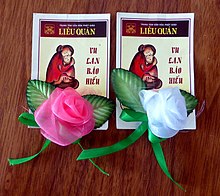
The traditional Chinese calendar is a lunisolar calendar, combining the solar, lunar, and other cycles for various social and religious purposes. More recently, in China and Chinese communities the Gregorian calendar has been adopted and adapted in various ways, and is generally the basis for standard civic purposes, but incorporating traditional lunisolar holidays. However, there are many types and subtypes of the Chinese calendar, partly reflecting developments in astronomical observation and horology, with over a millennium plus history. The major modern form is the Gregorian calendar-based official version of the Mainland China, although diaspora versions are also notable in other parts of China and Chinese-influenced cultures; however, aspects of the traditional lunisolar calendar remain popular, including the association of the twelve animals of the Chinese Zodiac in relation to months and years.
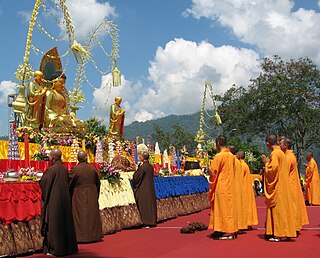
Vesak, also known as Buddha Jayanti, Buddha Purnima, Buddha Day, is a holiday traditionally observed by Buddhists in South Asia and Southeast Asia, as well as Tibet and Mongolia. It is the most important Buddhist festival. The festival commemorates the birth, enlightenment (Nibbāna), and passing (Parinirvāna) of Gautama Buddha in Theravada, Tibetan Buddhism and Navayana.

Chinese Buddhism or Han Buddhism is a Chinese form of Mahayana Buddhism which draws on the Chinese Buddhist canon as well as numerous Chinese traditions. Chinese Buddhism focuses on studying Mahayana sutras and Mahāyāna treatises and draws its main doctrines from these sources. Some of the most important scriptures in Chinese Buddhism include: Lotus Sutra, Flower Ornament Sutra, Vimalakirtī Sutra, Nirvana Sutra, and Amitābha Sutra. Chinese Buddhism is the largest institutionalized religion in mainland China. Currently, there are an estimated 185 to 250 million Chinese Buddhists in the People's Republic of China. It is also a major religion in Taiwan, Singapore, and Malaysia, as well as among the Chinese Diaspora.

Hungry ghost is a term in Buddhism, and Chinese traditional religion, representing beings who are driven by intense emotional needs in an animalistic way. The terms 餓鬼èguǐ literally "hungry ghost", are the Chinese translation of the term preta in Buddhism and is a Sanskrit word. "Hungry ghosts" play a role in Chinese Buddhism and Taoism as well as in Chinese folk religion. The term is not to be confused with the generic term for "ghost" or damnation, 鬼guǐ. The understanding is that all people become such a regular ghost when they die, and would then slowly weaken and eventually die a second time.
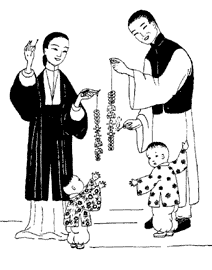
The Qingming Festival or Ching Ming Festival, also known as Tomb-Sweeping Day in English, is a traditional Chinese festival observed by ethnic Chinese in mainland China, Hong Kong, Macau, Taiwan, Malaysia, Singapore, Cambodia, Indonesia, Philippines, Thailand, and Vietnam. A celebration of spring, it falls on the first day of the fifth solar term of the traditional Chinese lunisolar calendar. This makes it the 15th day after the Spring Equinox, either 4, 5 or 6 April in a given year. During Qingming, Chinese families visit the tombs of their ancestors to clean the gravesites and make ritual offerings to their ancestors. Offerings would typically include traditional food dishes and the burning of joss sticks and joss paper. The holiday recognizes the traditional reverence of one's ancestors in Chinese culture.

Obon or just Bon is a fusion of the ancient Japanese belief in ancestral spirits and a Japanese Buddhist custom to honor the spirits of one's ancestors. This Buddhist custom has evolved into a family reunion holiday during which people return to ancestral family places and visit and clean their ancestors' graves when the spirits of ancestors are supposed to revisit the household altars. It has been celebrated in Japan for more than 500 years and traditionally includes a dance, known as Bon Odori.
The segaki is a ritual of Japanese Buddhism, traditionally performed to stop the suffering of the such restless ghosts/monsters as Gaki, Jikininki and Muenbotoke--the dead who have no living relatives)--all ghosts tormented by an insatiable hunger. Alternatively, the ritual forces them to return to their portion of hell or keeps the spirits of the dead from falling into the realm of the gaki. The segaki may be performed at any time, but traditionally performed as part of the yearly Urabon'e services in July to remember the dead and the segaki ritual for offering alms to specifically hungry gaki or muenbotoke, not for spirits of one's ancestor.

Preta, also known as hungry ghost, is the Sanskrit name for a type of supernatural being described in Hinduism, Buddhism, Taoism, and Chinese folk religion as undergoing suffering greater than that of humans, particularly an extreme level of hunger and thirst. They have their origins in Indian religions and have been adopted into East Asian religions via the spread of Buddhism. Preta is often translated into English as "hungry ghost" from the Chinese and East Asian adaptations. In early sources such as the Petavatthu, they are much more varied. The descriptions below apply mainly in this narrower context. The development of the concept of the preta started with just thinking that it was the soul and ghost of a person once they died, but later the concept developed into a transient state between death and obtaining karmic reincarnation in accordance with the person's fate. In order to pass into the cycle of karmic reincarnation, the deceased's family must engage in a variety of rituals and offerings to guide the suffering spirit into its next life. If the family does not engage in these funerary rites, which last for one year, the soul could remain suffering as a preta for the rest of eternity.

Buddha's Birthday or "'Buddha Day"' is a primarily Buddhist festival that is celebrated in most of South, Southeast and East Asia, commemorating the birth of the prince Siddhartha Gautama, who became the Gautama Buddha and founded Buddhism. According to Buddhist tradition and archaeologists, Gautama Buddha, c. 563-483 BCE, was born at Lumbini in Nepal. Buddha's mother was Queen Maya Devi, who delivered the Buddha while undertaking a journey to her native home, and his father was King Śuddhodana. The Mayadevi Temple, its gardens, and an Ashoka Pillar dating from 249 BCE mark the Buddha's birth place at Lumbini.

Śāriputra was one of the top disciples of the Buddha. He is considered the first of the Buddha's two chief male disciples, together with Maudgalyāyana. Śāriputra had a key leadership role in the ministry of the Buddha and is considered in many Buddhist schools to have been important in the development of the Buddhist Abhidharma. He frequently appears in Mahayana sutras, and in some sutras, is used as a counterpoint to represent the Hinayana school of Buddhism.

The Yulanpen Sutra, also known as the Ullambana Sutra, is a Mahayana sutra concerning filial piety. It was translated from an Indic language and is found in Taisho 685 and Taisho 686 in Volume 16, the third volume of the Collected Sutra Section. Taisho 685 was translated by Dharmarakṣa from 265-311 CE and is entitled: 'The Buddha Speaks the Yulanpen Sutra'. Taisho 686 was translated by an unknown or lost translator during the Eastern Jin Dynasty and is entitled: 'The Buddha Speaks the Sutra of Offering Bowls to Repay Kindness'. According to Karashima, Taisho 686 is basically a more idiomatic adaptation of Taisho 685. It records the events which followed after one of the disciples of Shakyamuni Buddha, Maudgalyayana, achieves Abhijñā and uses his newfound powers to search for his deceased parents. In the end, Maudgalyayana finds his mother in the preta world and with the assistance of the Buddha, is able to save her. The East Asian Ghost Festival is based on this sutra.

Maudgalyāyana, also known as Mahāmaudgalyāyana or by his birth name Kolita, was one of the Buddha's closest disciples. Described as a contemporary of disciples such as Subhuti, Śāriputra, and Mahākāśyapa, he is considered the second of the Buddha's two foremost male disciples, together with Śāriputra. Traditional accounts relate that Maudgalyāyana and Śāriputra become spiritual wanderers in their youth. After having searched for spiritual truth for a while, they come into contact with the Buddhist teaching through verses that have become widely known in the Buddhist world. Eventually they meet the Buddha himself and ordain as monks under him. Maudgalyāyana attains enlightenment shortly after that.

The Petavatthu is a Theravada Buddhist scripture, included in the Minor Collection of the Pali Canon's Sutta Pitaka. It ostensibly reports stories about and conversations among the Buddha and his disciples, and it dates to about 300 BC at the earliest. It is composed of 51 verse narratives describing specifically how the effects of bad acts can lead to rebirth into the unhappy world of petas (ghosts) in the doctrine of kamma. More importantly, it details how meritorious actions by the living can benefit such suffering beings.

Pchum Ben is a Cambodian 15-day religious festival, culminating in celebrations on the 15th day of the tenth month in the Khmer calendar, at the end of the Buddhist Lent, Vassa. In 2024, Pchum Bun will begin on October 1 and end on October 3.
This is a list of holidays celebrated within the Buddhist tradition.

Laba Festival is a traditional Chinese holiday celebrated on the eighth day of the month of La, the twelfth month of the Chinese calendar. It is the beginning of the Chinese New Year period. It is customary on this day to eat Laba congee.

Chinese folklore features a rich variety of ghosts, monsters, and other supernatural creatures. According to traditional beliefs a ghost is the spirit form of a person who has died. Ghosts are typically malevolent and will cause harm to the living if provoked. Many Chinese folk beliefs about ghosts have been adopted into the mythologies and folklore of neighboring East Asian cultures, notably Japan, Korea, and Vietnam. Beliefs about ghosts are closely associated with Chinese ancestor worship, where much have been incorporated into Buddhism and in turn influenced and created uniquely Chinese Buddhist beliefs about the supernatural.
In Buddhist studies, particularly East Asian Buddhist studies, post-canonical Buddhist texts, Buddhist apocrypha or Spurious Sutras and Sastras designate texts that are not accepted as canonical by some historical Buddhist schools or communities who referred to a canon. The term is principally applied to texts that purport to represent Buddhist teaching translated from Indian texts, but were written in East Asia.

Mulian Rescues His Mother or Mulian Saves His Mother From Hell is a popular Chinese Buddhist tale first attested in a Dunhuang manuscript dating to the early 9th century CE. It is an elaboration of the canonical Yulanpen Sutra which was translated from Indic sources by Dharmarakṣa sometime between 265 and 311 CE. Maudgalyayana, whose abbreviated Chinese transliteration is Mulian, seeks the help of the Buddha to rescue his mother, who has been reborn in the preta world or in the Avici Hell, the karmic retribution for her transgressions. Mulian cannot rescue her by his individual effort, however, but is instructed by the Buddha to offer food and gifts to monks and monasteries on the fifteenth day of the seventh lunar month, which established the Ghost Festival. While Mulian's devotion to his mother reassured East Asians that Buddhism did not undermine the Confucian value of filial piety and helped to make Buddhism into a Chinese religion, it also reflected strong undercurrents of filial piety that existed throughout Indian Buddhism as evidenced through its canonical texts and epigraphical remains.
Stephen F. Teiser is the D. T. Suzuki Professor in Buddhist Studies and Professor of Religion at Princeton University, where he is also the Director of the Program in East Asian Studies. His scholarship is known for a broad conception of Buddhist thinking and practice, showing the interactions between Buddhism in India, China, Korea and Japan, especially in the medieval period; for the use of wide-ranging sources, not only texts and documents, but artistic and material; for a theoretical approach that builds insights from history, anthropology, literary theory, and religious studies; and for seeing Buddhism in both elite and popular contexts.

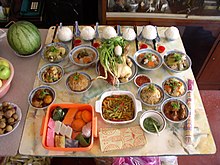

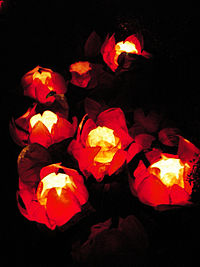


![Various food items being sacrificed for the wandering souls in Thang Co Hon [vi] Food offerings for the Mid-Autumn festival in Ecopark (2017).jpg](http://upload.wikimedia.org/wikipedia/commons/thumb/7/77/Food_offerings_for_the_Mid-Autumn_festival_in_Ecopark_%282017%29.jpg/220px-Food_offerings_for_the_Mid-Autumn_festival_in_Ecopark_%282017%29.jpg)
![Buddhists and monks prepare to water lanterns on the occasion of Vu Lan [vi] festival OMD40445 (27821684578).jpg](http://upload.wikimedia.org/wikipedia/commons/thumb/e/ec/OMD40445_%2827821684578%29.jpg/220px-OMD40445_%2827821684578%29.jpg)
